What Baby Orange Color Snake in North Carolina
Corn Snakes are 1 of the all-time beginner snakes as they stay small, take a simple diet and enjoy handling. They are also popular for their unique color and pattern combinations.
In total in that location are over 800 corn snake morphs. Each morph has its own unique design or colour.
Morphs are selectively bred by professional breeders. Their goal is to produce a unique pattern, color or combination of both.
If you are looking for a unique and fun serpent to bring domicile then keep reading…
Tabular array of Contents
- Corn Snake Morphs Colour Chart
- Top 40 Corn Snake Morphs
- 1. Lavender
- 2. Okeetee
- 3. Snow
- iv. Palmetto
- v. Black
- half-dozen. Scaleless
- 7. Miami Stage
- 8. Ghost
- 9. Blizzard
- x. Blood Red
- 11. Hypomelanistic
- 12. Florida
- 13. Bluish
- 14. Sunkissed
- fifteen. Candy Pikestaff
- 16. Pink
- 17. Fancy
- eighteen. Caramel
- xix. Creamsicle
- 20. Normal
- 21. Motley
- 22. Coral Snow
- 23. Eastern
- 24. Butter
- 25. Amelanistic
- 26. Tessera
- 27. Texas
- 28. Reverse Okeetee
- 29. Jungle
- xxx. Opal
- 31. Pewter
- 32. Ruby-red
- 33. Fluorescent Orange
- 34. Peppermint Stripe
- 35. Anerythristic A
- 36. Anerythristic B
- 37. Blood Carmine Pied-Sided
- 38. Cerise Amelanistic
- 39. Slowinski'southward
- forty. Zig-Zag
- Summary
Corn Snake Morphs Colour Chart
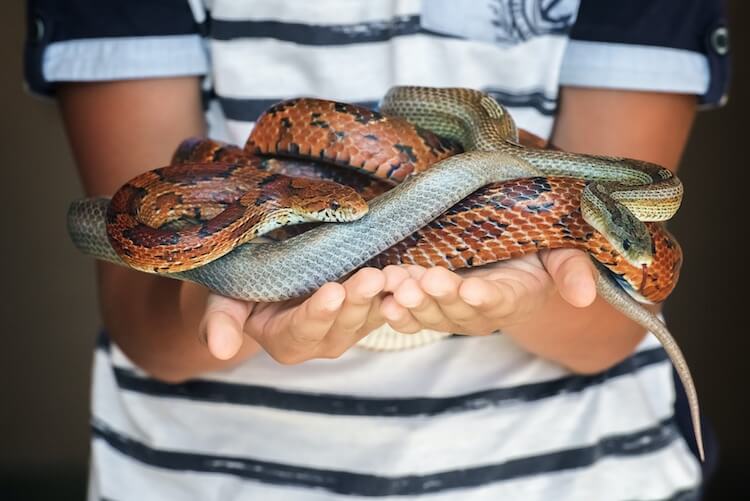
Corn snakes were some of the first snakes bred in captivity for color variation – at that place are at present 830 documented morphs.
Some of these morphs are naturally occurring mutations. South Carolina and Florida have many natural corn snakes.
Many corn snake morphs are selectively bred. Color morphs are typically more popular than pattern variations.
The most pop colors are Lavender, Snowfall and Blackness:
| Morph | Color | Price | Rank |
|---|---|---|---|
| Amelanistic | Depression contrast red with yellows and oranges. | $fifty – $75 | 25 |
| Anerythristic A | Pale greyness with dark gray blotching and blackness margins. | $seventy | 35 |
| Anerythristic B | The same every bit Anerythristic A morphs but they not develop xanthous coloring with age. | $100 | 36 |
| Blackness | Dark gray with charcoal blotching outlined by black margins. | $100 | 5 |
| Blizzard | Completely white with reddish eyes. | $150 | ix |
| Blood Red | Vibrant red with faint or no patterning and a white abdomen. | $seventy | 10 |
| Blood Red Pied-Sided | Deep red with some faint patterning and a white abdomen. | $250 | 37 |
| Blue | Blue-greyness with darker gray blotches. | $200 | 13 |
| Butter | A bright yellow snake with red eyes. | $seventy | 24 |
| Candy Cane | High contrast of red and white. | $50 | 15 |
| Caramel | Yellow-brownish base with caramel, low-cal dark-brown or rich chocolate dorsal and lateral blotches. | $forty | xviii |
| Coral Snow | Light pink and peachy-orange blotchings with a white faded belly. | $130 | 22 |
| Creamsicle | A yellowish base of operations with nighttime xanthous-orange blotches. | $70 | nineteen |
| Crimson | High color contrast snakes with a dazzling red color scheme. | $seventy | 32 |
| Eastern | Tan or brown and reddish-orange dorsal and lateral blotches. | $xxx | 23 |
| Florida | Tan-orange base color with reddish-orangish blotches. | $thirty | 12 |
| Fluorescent Orangish | Vibrant orangish with dark red splotches and white margins. | $140 | 33 |
| Ghost | Pale grayness base color with a muted color. | $50 | 8 |
| Hypomelanistic | Vibrant combinations of light reds, whites, oranges and yellows. | $70 | 11 |
| Jungle | An unpredictable codominant morph. | $80 | 29 |
| Lavender | Pink base color and lavender blotching. | $75 | i |
| Miami Phase | Silver base color with burnt-orange blotches. | $lxx | 7 |
| Motley | Night lines downwards their spine and belly scales with dashed lateral blotching. | $50 – $70 | 21 |
| Normal | Scarlet-chocolate-brown blotches on light brown or grey. | $xxx | twenty |
| Okeetee | Deep red or burnt orange dorsal blotches and a medium chocolate-brown or deep orange base of operations. | $fifty | two |
| Opal | Near white with a faint yellow patterning and burgundy eyes. | $65 | 30 |
| Palmetto | White with random red, orange, and yellow scales. | $ane,500 | 4 |
| Peppermint Stripe | Dark pink with faint pink striping forth their body. | $175 | 34 |
| Pewter | Silver-lavender snakes with faint blotching that fades with age. | $xc – $100 | 31 |
| Pink | Calorie-free pinkish and pale dorsal blotches with orange center stripes. | $120 | 16 |
| Ruby Amelanistic | Bright reds and oranges and vibrant cerise dorsal blotches. | $100 | 38 |
| Reverse Okeetee | Peach with scarlet-orange blotches surrounded by a thick white margin. | $125 | 28 |
| Scaleless | Their trunk is without scales. | $500 | vi |
| Slowinski's | Grayish-brown with large chocolate brownish dorsal blotches. They also accept black and white belly checkers. | [n.a.] | 39 |
| Snowfall | White with pink or beige patterning. | $100 | 3 |
| Sunkissed | A beautiful combination of sunset orange and cherry-red with a masquerade-mask shaped head blueprint. | $fourscore | 14 |
| Tessera | Thin dark-edged dorsal stripes and dense square lateral blotches. | $80 | 26 |
| Texas | Lite beige base color with ruddy-brown dorsal blotches. | $30 | 27 |
| Zig-Zag | A blueprint morph that only changes the abdomen of the snake. | $175 | 40 |
Acme 40 Corn Snake Morphs
one. Lavender
The Lavender morph is a beautifully unique colour variant with the standard corn serpent pattern.
Hatchlings are typically dark grey with purple patterning. Adults normally burnish with age to have a pink base color and lavender blotching.
Sometimes lavander snakes accept a chocolate-brown or orangish base color. Despite having the lavender genetic trait these snakes are actually known equally "mocha" or "cocoa" morphs.
The first lavender variety was bred in the 1980s as a cross betwixt a snowfall corn (#3) and a wild-defenseless ophidian. Since so these beautiful snakes have remained the most pop corn serpent morph.
They tin can be purchased for $75.
2. Okeetee
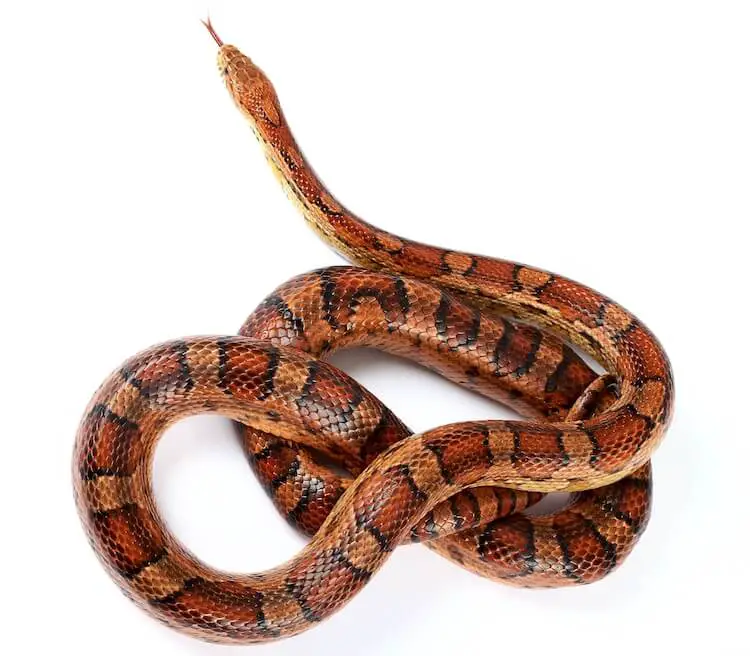
The Okeetee is a wild morph that was first discovered in Southward Carolina. Collectors took specimens and began convenance them in captivity.
Okeetees are still constitute in the wild. However, over collecting has led to a population reject and reduced sightings.
These morphs accept deep crimson or burnt orange dorsal blotches with black margins. They besides have yellow or orange lateral blotches on their bodies.
Their base color is always a medium brown or deep orange.
If you are considering an Okeetee corn then select a private breeder. Purchasing captive bred snakes is important to reduce pressure level on the wild population.
3. Snow

The Snow corn snake is sometimes known as a "white albino". White albinos are cute snakes that can exist purchased for $100.
This morph is a combination of the Amelanistic (#25) and Anerythristic A (#35).
Snowfall morphs are predominantly white merely tin take pale blotching. Some may take pink or beige patterning.
These snakes are totally white as hatchlings and develop coloration as adults. Fully grown they usually take a yellow throat and neck.
This variety cannot occur naturally in the wild so they must be captive bred. Both traits (Amelanistic and Anerythristic A) are recessive.
4. Palmetto
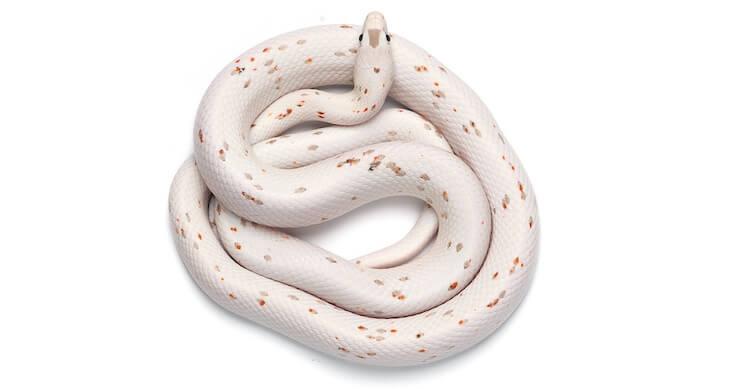
The Palmetto morph is possibly one of the most unique in this list.
They are a effect of incomplete authorisation genes when 2 recessive leucistic traits are bred together.
These morphs are white with random ruby, orange, and yellow scales speckled beyond their trunk. They too have jet black pupils surrounded past fair or blue-white irises.
In 2008 the showtime wild Palmetto morph was discovered and collected from South Carolina.
Since then only 1 more wild citing has been reported.
The breeder who nerveless the first wild palmetto was able to produce offspring. They sold the first captive clutch for $4,000. Today these snakes are priced at $1,500.
5. Blackness

The Black morph is likewise called the Black Devil'south Garden corn snake.
Their proper name comes from the place they are normally establish in Southwestern Florida. The but way to guarantee a Blackness Devil'south Garden morph is if the breeder knows the parent was nerveless from this expanse.
These snakes are typically dark gray with charcoal blotching outlined by black margins. As juveniles they have a much higher dissimilarity of light to night gray – similar to baby blackness rat snakes.
Black morphs are part of the anerythristic species.
Anerythristic species have a recessive trait that is so prevalent the bulk of corn snakes in the region either display the trait or carry the recessive allele.
6. Scaleless
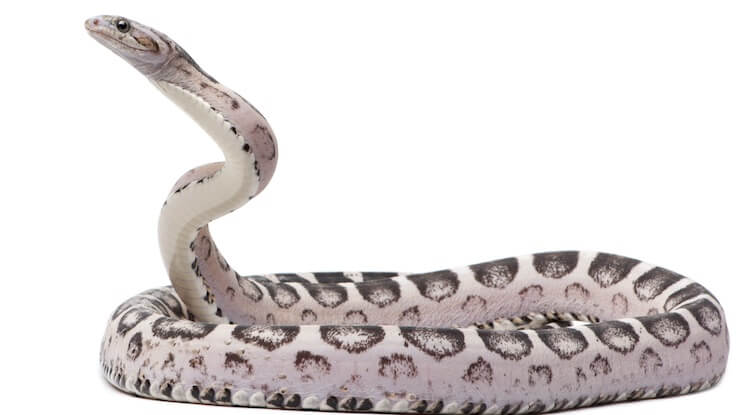
The Scaleless corn morph is the most unique pattern morph. They are rarer than the Sunkissed Corn Snake (#xiv). This $500 ophidian is very rare to see.
They are a hybrid snake bred from a Great Plains Rat Serpent and common corn snake.
Scaleless snakes have no scales on their body. However, they all the same have full or partial belly scutes – otherwise they would be unable to slither.
These snakes are beautiful and their lack of scales highlights their natural color patterns.
7. Miami Phase
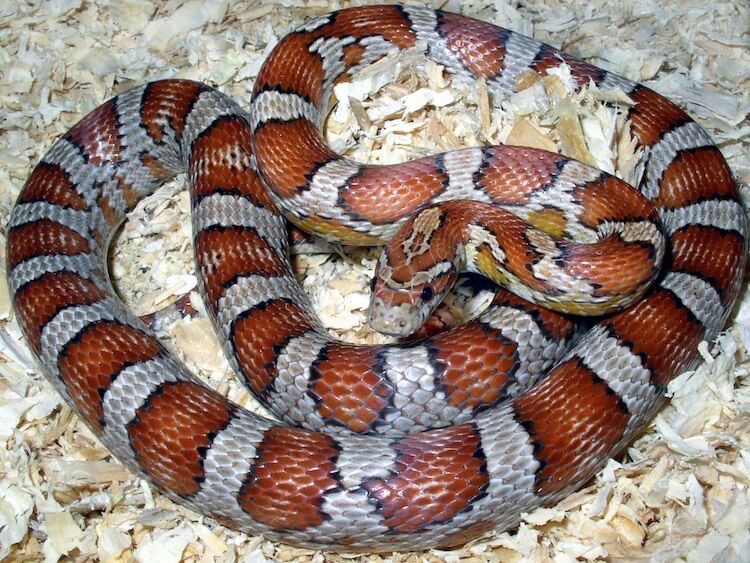
The Miami phase is named after the area of Florida they are found in – Miami-Dade county.
An interesting fact about this morph is that because of where they live, they prefer to eat lizards and not rodents. This can make information technology difficult for them to feed on rodents in captivity.
A convict bred Miami can be purchased for $70.
These corn snake morphs are famous for their unique silver base color.
They have burnt-orange blotches lined with black margins. Captive breeding has increased the contrast in this variety over fourth dimension.
eight. Ghost

Ghosts are a blazon of designer corn snake morph.
They are selectively bred past mating hypomelanistic snakes with anerythristic type A (#35) morphs.
Ghost morphs have a normal blueprint but have a muted color.
They are normally a pale grey and have reddish-brown dorsal blotches. Interestingly, halfway downward their body their color and pattern inverses – their base becomes reddish-brown and their blotches go gray!
Another reason these morphs are popular is because they are phenotypically codominant. When they are bred with other corn serpent morphs, they produce pastel or neutral colors.
ix. Blizzard
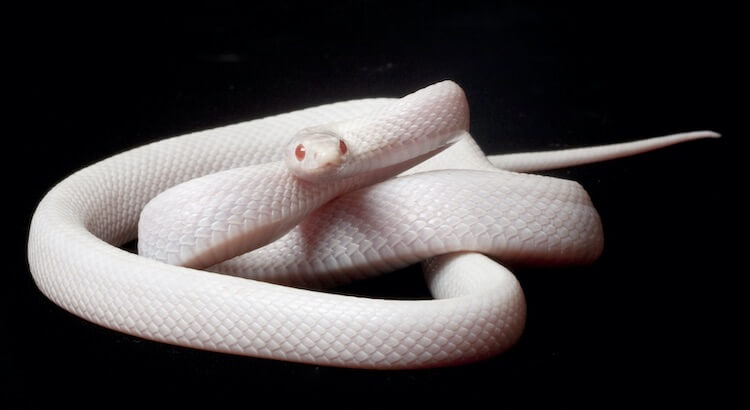
The Blizzard morph is one of the more beautiful corn snakes and can be purchased for $150.
The get-go Blizzard was born in 1984. A wild caught anerythristic type B (#36) corn snake was collected and bred with a charcoal morph.
These snakes are born completely white with crimson eyes.
As they age sometimes they may develop faint "lemon-lined" margins around their blotches. They may also develop yellowish checkering on their belly.
x. Claret Red
The Blood Red corn snake morph is vibrant crimson and does non normally have patterning.
Hatchlings take some patterning just this fades with age – making adults more desirable than juveniles.
The crimson colour comes from a recessive trait that was discovered past mating wild caught snakes.
Red morphs accept completely white bellies! Because corn snakes are known for their abdomen patterns, the absence of any pattern makes them desirable to breeders.
11. Hypomelanistic
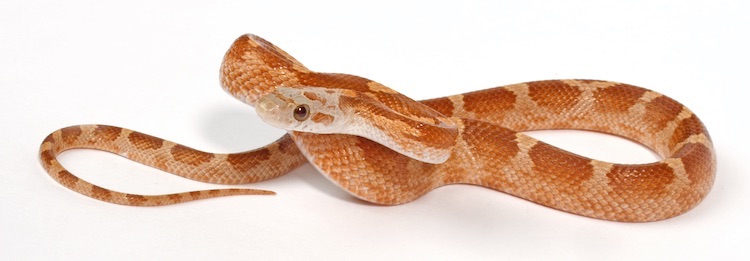
Hypomelanistic morphs are sometimes called Rosy corn snakes.
These snakes are recessive then accept reduced melanin pigmentation. They tin expect like an albino or just a lighter-shade of color.
When compared to other corn serpent morphs they are a lighter shade of color. This is because they accept very fiddling nighttime pigmentation (i.e. dark-brown or black pigment).
Their lack of night pigmentation allows them to be vibrant combinations of light:
- Red
- White
- Orangish
- Yellowish
- Grayness
- Brown
When combined with codominant genes this trait can create beautiful hybrids that tin can be purchased for $70.
12. Florida
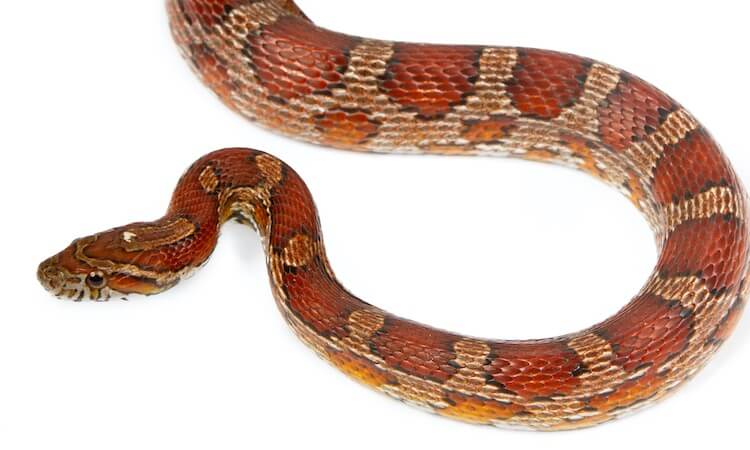
The Florida corn snake is besides known as the:
- Eastern Corn Serpent (#23)
- Craven Snake
- Red Rat Ophidian
This snake is a wild type color variation that tin can exist found all across the land of Florida. Because of their normal appearance they can exist purchased for $xxx.
Florida also is home to the Black Devil's Garden (#5) and Miami Phase (#7) morphs. All of these snakes are the same species (P. guttatus) merely are sometimes considered carve up subspecies.
The Florida corn ophidian morph has a tan-orangish base color and cherry-orange blotches with black margins – similar to the common Carolina corn snake.
Occasionally this multifariousness can take a gray base color.
13. Blue
The bluish corn snake morph has the blueish dilute factor. This gene is produced past convenance the codominant dilute and charcoal morphs (#36):
- The dilute gene reduces blackness pigment.
- The charcoal morph removes the scarlet color.
This leaves a gray ophidian that sometimes takes on a bluish hue.
Their bluish-gray base color has darker gray blotches. As adults their pattern may fade and leave a blue-gray trunk with variable hues.
You tin can notice a blue for $200 from a reputable breeder.
14. Sunkissed
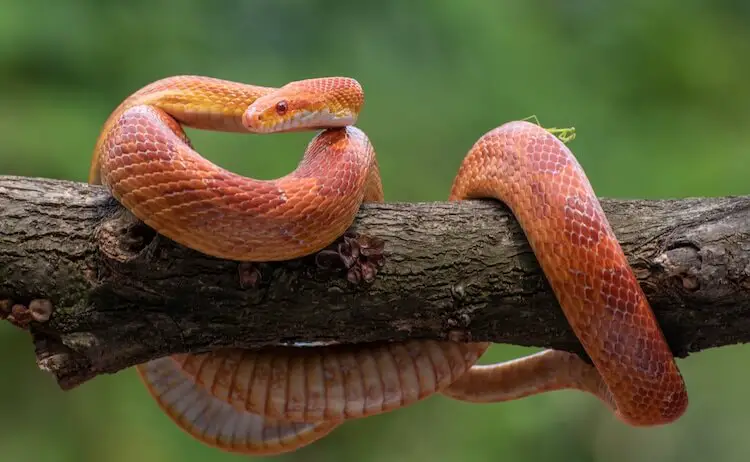
The Sunkissed corn snake morph is a beautiful combination of sunset orangish and red.
This recessive gene (i.eastward. hypomelanistic c trait) changes the snake's pattern and colour.
Sunkissed morphs have a dark ruby-orange color with deep red dorsal and lateral blotches.
Their pattern causes lateral blotches to form dense, squarish shapes – rather than small even blotches. Their head has a singled-out masquerade-mask shaped pattern of dark crimson-orange on a lighter orange base.
15. Candy Pikestaff
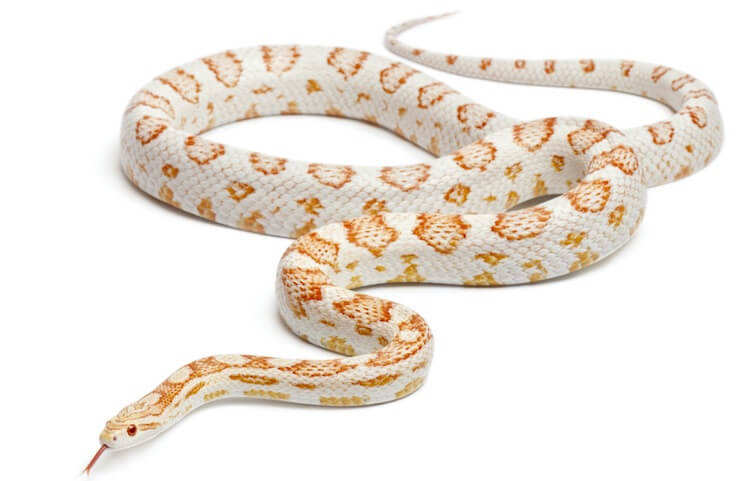
The Candy Cane is a high contrast color variation that is adorable.
Candy Canes are bred from a recessive amelanistic gene. This is normally introduced by breeding 2 Miami Phase morphs (#vii) together – or a Miami and Creamlike (#19) morph.
As hatchlings these snakes have a white base color with vibrant carmine dorsal and lateral blotches. The high contrast of crimson and white is what gives the Processed Pikestaff its name.
As they age this snake'south color may either fade or develop an orangish coloration effectually their neck.
This colorful morph can exist purchased for $50.
16. Pink
The Pink morph is a designer snake that is a combination of the dilute-amelanistic (#25) and motley blueprint (#21).
Pink corn serpent morphs have a light pink base with thick red margins.
They accept pale dorsal blotches with orange center stripes.
Like near motley pattern morphs they have elongated dashes instead of lateral blotches. These dashes are red. Their eyes are red as well.
Pinkish morphs require several genes to produce which gives them a higher price of $120.
17. Fancy
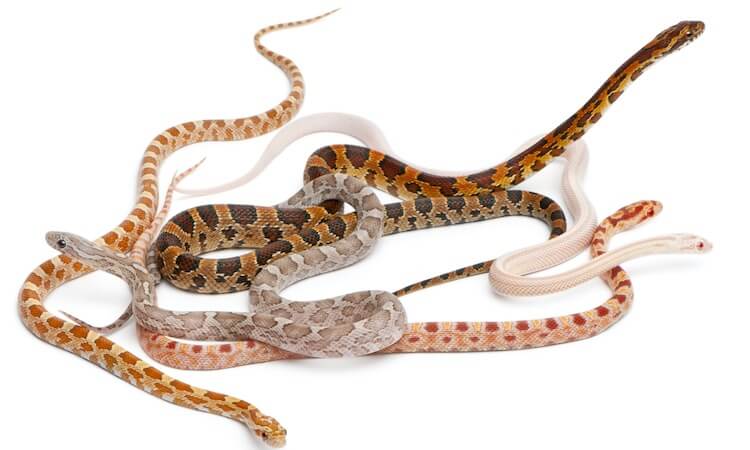
Fancy corn snakes are not a single morph!
Instead "fancy" is a collective term used to draw any corn snake that is not common (i.e. normal).
Pet stores or places that do not specialize in convenance snakes oft refer to unknown morphs every bit fancy because they don't know the full genetic limerick.
If you accept purchased a fancy variety experience free to post a comment so we can help you identify it.
18. Caramel
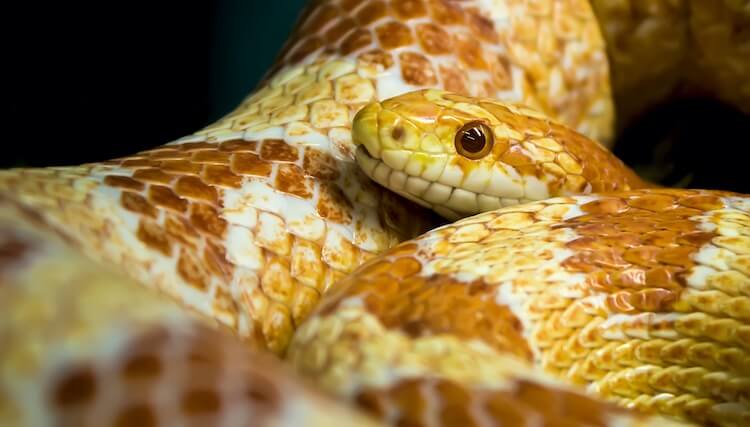
Another popular corn serpent morph is the Caramel.
The showtime Caramel was wild caught and brought into captivity. After careful breeding consequent clutches began beingness produced in captivity.
Caramels tend to have a yellow-chocolate-brown base. Their dorsal and lateral blotches can be caramel, light chocolate-brown or rich chocolate.
Their mutual appearance and ease of convenance hateful you can purchase them for $forty.
xix. Creamsicle
The Creamsicle is a designer corn snake morph that takes two rounds of breeding:
- An Emory's Rat snake is commencement bred with an Eastern (#23).
- The offspring is and so bred with an albino corn ophidian.
Creamsicles commonly have more yellow and less red. They have a xanthous base with night xanthous-orange blotches and thin margins.
They too take red eyes.
Creamsicle corn snake morphs can be purchased for $70.
20. Normal
"Normal" is the name given to a standard wild type corn ophidian.
The Normal corn snake typically has reddish-brownish blotches on a light brown or grayness base. The simply variation is the Carolina species that has vibrant oranges and reds.
This serpent is commonly used by breeders to produce other morph variations.
21. Motley
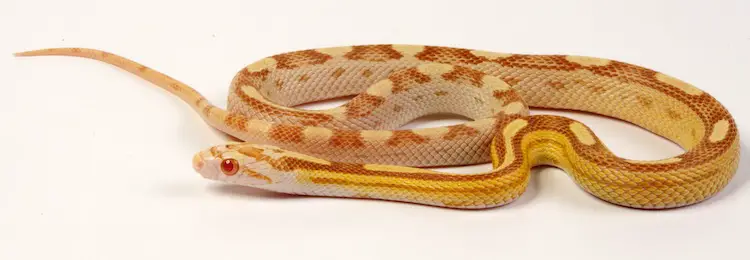
The Motley corn serpent is a pattern morph – not a color morph.
Corn serpent pattern morphs typically do non affect the color of the snake's scales.
The Motley pattern was the first recessive pattern morph discovered and has one of the virtually complex deportment.
A Motley design creates night lines downwards the spine and sides of the belly scales. Lateral blotching is also reduced and may appear as dashes.
Motley snakes are common and cost $fifty – $70.
22. Coral Snow
This designer morph is a combination of Hypomelanistic A, Amelanistic (#25), and Anerythristic (#36) genes. Because of their albino genes they have red eyes.
Coral Snows have a low-cal pinkish colour with keen-orange blotching.
They sometimes have calorie-free pink or white margins and xanthous forth the sides of their body.
Their bellies are normally white with pale or faded markings – unlike the loftier dissimilarity checkers in near corn serpent morphs.
23. Eastern
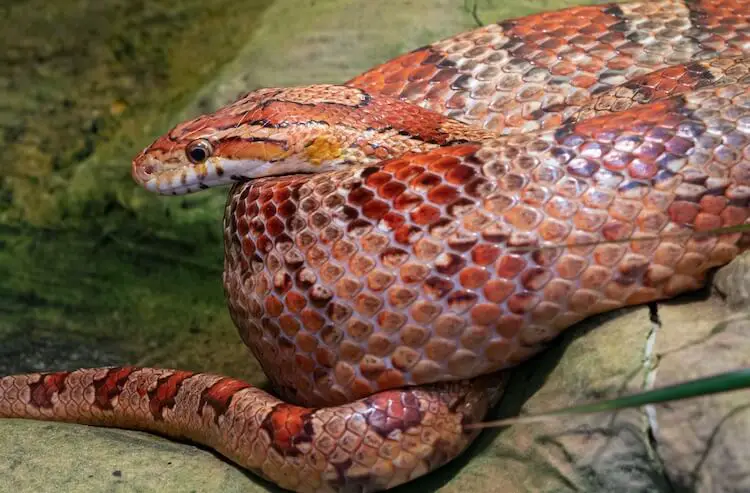
Eastern corn snakes are a wild type corn ophidian.
They are found eastward of the Mississippi and from New Jersey to the tip of Florida.
Easterns are not endangered and are easy to detect. Withal, buying a captive bred specimen from a breeder is always recommended.
Scientifically this ophidian is known as the Pantherophis guttatus species and comes in a variety of colors.
Easterns are tan or brown and accept reddish-orange dorsal and lateral blotches.
This corn snake is very like to the Carolina and Florida species, however Eastern is the true name for this species.
24. Butter
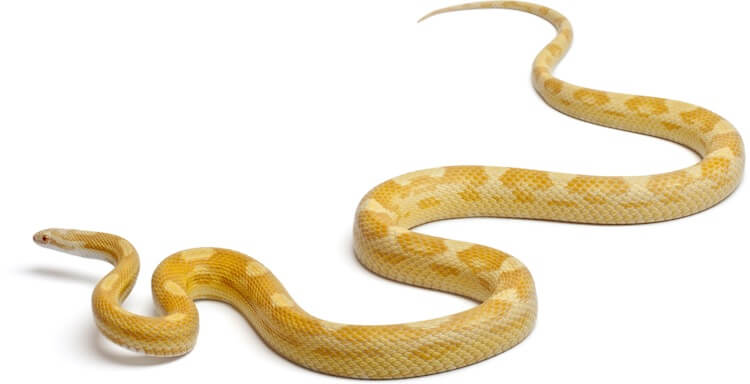
The Butter morph is likewise known equally a Snowfall Caramel because it is a hybrid of the Snow (#3) and Caramel (#18) morphs.
Selective breeding has produced a bright yellow snake with red eyes.
The yellow base of operations is typically lighter than their blotches.
Their design is fairly like to a wild design.
25. Amelanistic
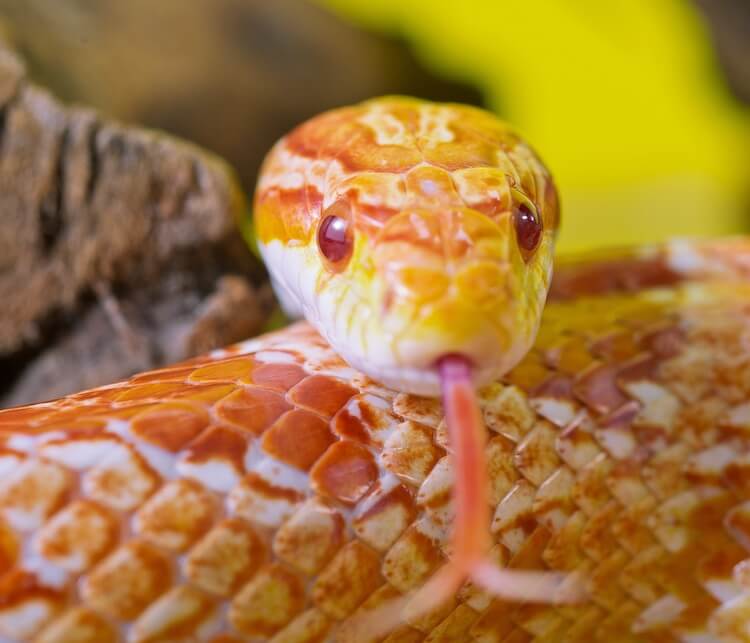
The first wild Amelanistic corn ophidian was collected in North Carolina in 1953. Withal, they were not successfully bred until 1961.
The Amelanistic morph is the factor source for the standard albino.
This gene is recessive and is inherited through normal convenance. Every amelanistic snake lacks the brown and black pigments found in melanin.
These snakes are very low dissimilarity and fifty-fifty have blood-red optics.
Compared to the Red Albino (#38) this corn snake has more yellows and oranges.
26. Tessera
The Tessera is the second pattern morph in this listing.
Motley (#21) was the first recessive pattern and Tessera was the first ascendant blueprint.
Tesseras usually have 1 thin dark-edged dorsal stripe and dense square lateral blotches.
Homozygous Tesseras cannot exist produced. It is thought the homozygous class of Tesseras is a lethal gene.
Standard Tesseras tin can exist purchased for $fourscore simply hybrids with rare colors are more than expensive.
27. Texas
The Texas corn serpent is another regional subgroup of this species – like to the Eastern (#23).
They are wild blazon corn snake that cost $30.
Texas corns commonly have a light biscuit base color with reddish-chocolate-brown dorsal blotches that take strong black margins.
They take two stripes that cross their eyes and meet in a signal between them.
28. Reverse Okeetee
The Reverse Okeetee is also known as an Albino Okeetee.
These snakes normally have a peach base with ruby-red-orangish blotches that are surrounded by a thick white margin.
Their pattern is identical to the Standard Okeetee (#2) – merely without melanin pigments.
Contrary Okeetees retain their contrast and vibrancy into adulthood and cost $125.
29. Jungle
The Jungle corn snake is an interspecies hybrid!
Jungle morphs are the issue of mating a normal Corn Ophidian with a California King Snake.
These two species course an unpredictable codominant corn ophidian morph.
Some are black and white with aspects of both patterns. Some look exactly like ane parent and are tan or brown with a single blueprint.
This morph is very interesting simply their unpredictability and inability to breed makes them $80.
30. Opal
The Opal corn snake is a designer morph.
They are a recessive combination of the Amelanistic (#25) and Lavander (#1) morphs.
The change from hatchling to adult is ane of the most drastic changes of whatsoever variety on this list.
Hatchling Opals are a low-cal pink color with peach blotches and white margins. They have bright red pupils with pinkish irises – like to the Pink (#sixteen) variety.
Adults turn virtually white with a faint yellow patterning that is barely visible. Their eyes become burgundy also.
31. Pewter
Pewters are besides known as Peppercorn morphs.
They are a designer hybrid of the Anerythristic B (#36) and Claret Cherry-red (#10).
Pewters are normally a silver-lavender color with faint blotching that fades with historic period.
This species costs $90 – $100 depending on how clean their design is.
32. Cherry
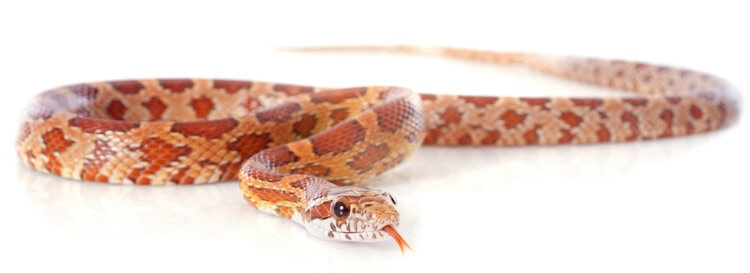
The Ruby morph is sometimes chosen the Red Corn Serpent. However, do not get this designer morph confused for a common red corn snake.
Crimsons are codominant snakes bred by convenance a Hypomelanistic (#11) to a Miami (#7).
They have a light base of operations and dark red-orange blotching.
These snakes have a loftier colour dissimilarity with a dazzling red color scheme.
33. Fluorescent Orangish
The Fluorescent Orange is an interesting color morph that combines several recessive amelanistic genes.
They also modify color with age.
Hatchlings are pinkish with very light orange colorations.
Adults take on a vibrant orange base with dark red splotches and white margins.
34. Peppermint Stripe
The Peppermint Stripe is a unique combination of the recessive amelanistic, cinder and stripe traits.
Peppermint stripes are normally a night pinkish with faint pink striping along their body. Adults can fade to a speckled-pink.
They have red pupils with pink irises and a clean white belly.
Young Peppermints tend to have cloud-like fading on their heads. This intensifies to a pale pinkish with age.
These snakes cost $175 because of their unique blueprint and difficult breeding requirements.
35. Anerythristic A
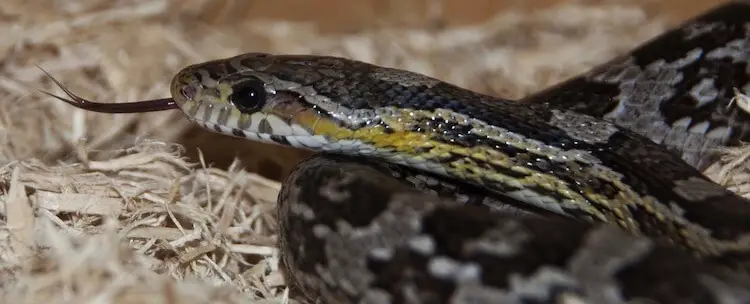
The Anerythristic type A morph is also known every bit the Anery or Black Albino corn ophidian morph.
Anerythristicism is the lack red, orange and yellowish pigmentation.
Their torso coloration is a pale gray with nighttime gray blotching and black margins.
As adults they tin develop a yellow coloring around their pharynx and neck.
36. Anerythristic B
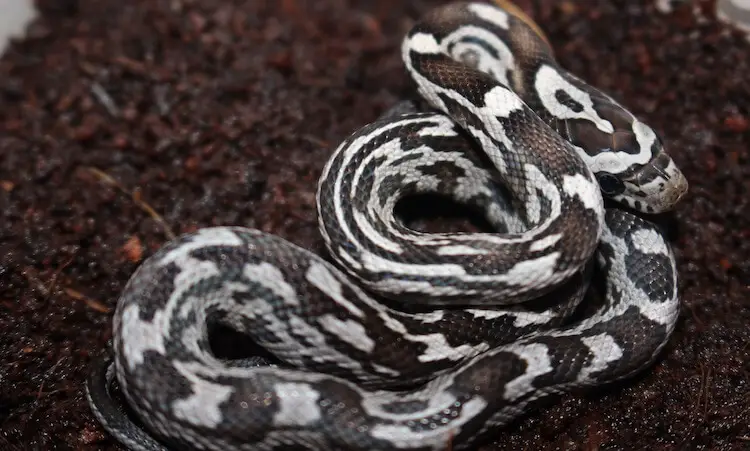
The first developed Anerythristic B was caught in 1984 in Florida and was used to assistance showtime the Blizzard morph (#7) lines.
The Anerythristic blazon B corn snake is part of the same Anery circuitous as the blazon A (#35). The biggest difference is this species does not develop yellow coloring with historic period.
Just similar the Anery A they are pale greyness with night gray blotches and black margins.
Like all Anery morphs these snakes lack ruby, yellow and orange pigmentation.
This serpent is unremarkably used to mute or grey-out the coloration of other morphs and are therefore highly valued at $100.
37. Claret Red Pied-Sided
The Blood Cerise Pied-Sided morph is a highly valued species at $250.
They are a recent combination of the Blood Red (#10) gene and recessive Piebald cistron.
These snakes are deep cherry with some faint patterning and a white belly – like standard Blood Reds. The main difference is that the white trickles upwards the sides of the belly and beyond the lateral portion of the snake.
The pied gene is similar to that found in brawl pythons and is responsible for this snake's creeping white scales.
38. Red Amelanistic
The Red Amelantistic morph is also called the Red Albino and the Red Amel.
Red Amels are usually bright reds and oranges.
Their dorsal blotches are commonly vibrant red too.
They commonly have high variation and dissimilarity when compared to the yellow Amelanistic.
39. Slowinski's
The Slowinski is actually a different species of corn snake known every bit the Patherophis slowinskii.
They were only given species status in 2002 and are named after the famous herpetology Joseph Bruno Slowinski!
This snake is native to small regions of Louisiana, Texas and Arkansas.
Slowinski corn snakes take a grayish-brown base with large chocolate brown dorsal blotches. They too have black and white belly checkers.
The easiest way to know that yous have found a Slowinski is past their head pattern.
Their heads have two nighttime stripes along the sides that meet between their eyes in a signal – like a Texas (#27).
These are wild morphs and are rarely sold.
40. Zig-Zag
The Zig-Zag is also known as the Attachment.
This pattern morph only changes the belly of a corn snake.
Rather than the standard maize blueprint the Attachment morph causes the corn snake's belly scales to realign in a zig-zag pattern along the center of their belly.
It is a recessive trait that is existence stabilized for consistent use in breeding.
Most morphs with this pattern contain other designer genes such equally the Aztec or Zagtec.
Summary
Corn snake morphs are loved for their brilliant colors and unique patterns.
If yous are looking to add a small and unique snake to your drove one of these morphs will exist perfect!
They are also keen for beginners who want their kickoff snake. Corn snakes tolerate handling well, rarely show aggression and have a unproblematic nutrition.
If you similar some of the colors in this list, but are looking for a slower and larger beginner snake then bank check out some ball python morphs.
Which is your favorite? Do you already keep a corn snake?
Tell united states of america all about information technology in the comments below!
Source: https://www.everythingreptiles.com/40-corn-snake-morphs/
0 Response to "What Baby Orange Color Snake in North Carolina"
Post a Comment